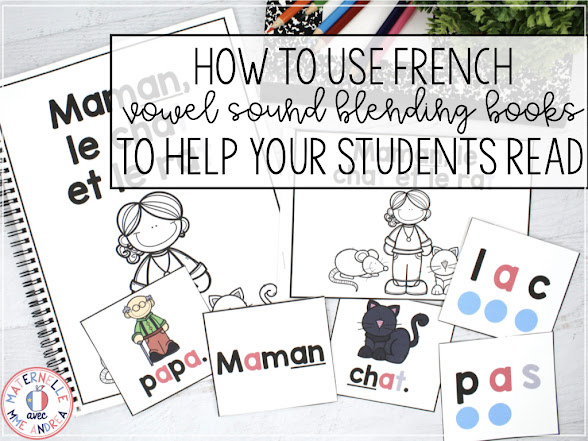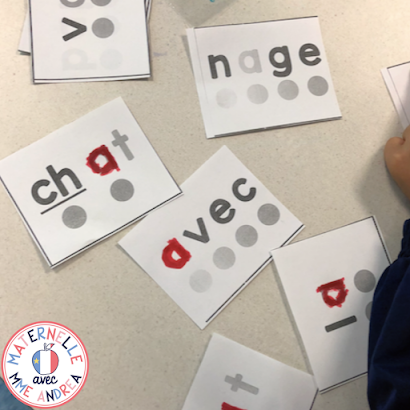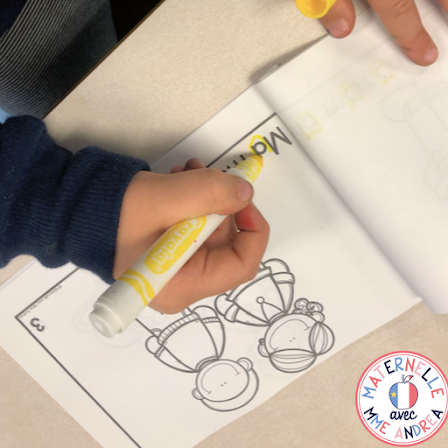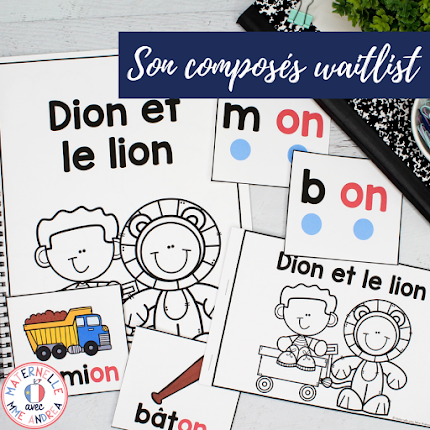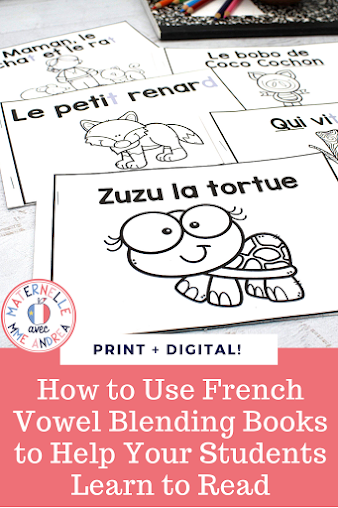Can you believe it — it’s already May!
That means the end of the school year is almost here — it’s home stretch time
Before the end of the year, I wanted to take a minute to share one of my FAVOURITE resources that came out of Covid times… vowel sound blending books!
This hybrid digital + print resource can be used to help your students learn to blend with 5 vowel sounds (a, e, i, o, u) via blending cards, sentence building cards, and a special story for each sound.
In NS, we just switched back to virtual teaching this week, so I’m actually working on a version two of these for sons composés. At the end of the post, I’ll share how you can get more info about how to access those books before anybody else!
Here’s a peek at my vowel sound blending books routine for in-person learning, plus some more info on why I made them in the first place.
MORE ABOUT WHY I MADE THIS RESOURCE
This resource was first started in spring of 2020, when we were suddenly tossed into distance teaching. In NS, I didn’t really do any live teaching — I just did pre-recorded videos.
I wanted a way to help my students practice decoding from a distance, but I had no way to actually get physical books to them. It was also May in maternelle — such a clutch time for making progress!
So, I made the book for Aa and tried it out with my class – I prerecorded a video of me reading the digital version as I went through the slides, and sent home the digital + print-at-home option so parents could choose one to have their child practice.
I asked parents to send me a video of their child reading the book… and I only got two back. Those two kids did GREAT, but it made me think that it wasn’t really an assignment that “translated” well for at-home learning. I put it on the back burner and decided to try it out in person instead (having no idea when that would actually happen).
Fast forward to this year, and I moved up with my students to grade one. At the start of the year, we were told sooo many rules, including that we couldn’t work with students in small groups, have our guided reading tables, etc. etc.
While all that was being sorted out, I felt like I just couldn’t wait any longer to get into teaching my students to read. Grade one is a massively important year at the best of times, and my students had missed SO MUCH at the end of maternelle.
Obviously, academics are on the back burner more-so this year than other years and we need to give ourselves grace, but my students were showing so much potential and I just had no idea when I would finally be able to get going.
I decided to revisit my vowel sound blending books and see if I could tweak them a bit to start guided reading whole group in première année (reminder: I always start in whole-group in maternelle and it works like a charm!)
I made a digital warm up, blending cards, and story that I could project for everyone at once, as well as printable copies that students could read on their own and take home for extra practice for each vowel sound (Aa, Ee, Ii, Oo, Uu – not Yy because not enough words).
I also built a 2-day routine for each book/sound that we followed.
Here is some more info on the routine I chose to use:
DAY ONE
1. Introduce the vowel of the day and ask students to produce the sound it makes à l’oral
2. Fluidité – warm students up by reviewing the letter SOUNDS (not names) and sight words on the fluidité slide (this is the first slide found in the resource).
3. Blending warm up — project the slides one at a time. As you point to the dot under each letter, students will produce the sound each letter makes and then blend them together. Ex. /v/…/a/… va! If my students rush and say the next sound when I’m still pointing to the first sound, I make them repeat.
It’s REALLY important that they get in the habit of LOOKING at the letters as they read. It’s also really important to get them to say the sounds all together and make an actual word once they are done blending.
Practicing this as a group has really made a difference for my students – more students than ever before repeat the word as a whole after they sound a word out this year, so yay!
4. Pass out individual blending cards (optional) – I cut mine ahead of time and handed out the black & white versions to each student. Everyone had a sandwich bag inside their reading bag that we added the cards to each time.
Before adding the cards to their bag, I had students fill in the target sound with red marker/crayon. As they coloured, I circulated and listened to them read a couple of cards to me
5. Once the cards are in their baggies, put the baggies aside and read the story together (projected). You can do this more than once, tricky pages more than once, whatever you like!
6. Pass out student copies and have them highlight the target letter/sound. Note: I wanted to focus on the target SOUND, so I did not have students highlight the letter if it was part of a « son composé ».
Ex. in the Oo book, students didn’t highlight the o in « voici » or « son ». They knew not to because of the underlined font (if they forgot, no biggie).
The point of highlighting is to help them remember what to do with their mouths when they see it!
You can have students colour the book in if you want — it’s not a big priority for me, but if some finished up quicker than others with highlighting the target sound, I had them colour a bit. Totally up to you!
7. Take the blending cards + books home in their reading bags to practice (*if your students struggled with reading the story successfully, wait to send it home on day 2 or even later if they need it).
DAY TWO
Remember — adjust/tweak anything as needed. Also, if you’re teaching virtually right now, you can totally follow this routine during your synchronous learning as closely as you can :)
1. Review: reread the warm up page and blending slides as a group. Then, re-read the digital story together
2. Game: I alternated between a couple options. If you want, you could spend 3-4 days on each sound and then do all the activities for all the sounds instead of alternating.
Game 1: Find it
- Students spread their blending cards face up on their desks.
- The teacher says one of the words from the 12 student blending cards really slowly, stretching each sound.
- Students « fusionnent » the sounds orally and then find the card on their desk that matches what the teacher said.
- If you let them slap the card, they get really into it! ;)
Game 2: Write it
- Students spread their blending cards face up on their desks.
- They will also need a white board (the backs of our clip boards have white board contact paper stuck to them) and dry erase markers.
- The teacher says a word, isolating each sound slowly.
- You might also put a _ on the board for each letter and say “x letters, x sounds” (ex. Mot = _ _ _; 3 letters, 2 sounds).
- Students fill in the blanks on their own white board, and find the word among their cards in order to correctly identify the « lettre muètte » and/or check their guess.
After a few words with the target letter, I like to toss in a few of the other words we have seen in other vowel books as review. You don’t have to have them use their cards to check; you can just correct as a class if you prefer.
*When it comes to « les lettres muèttes », I just tell my students that we try to put these words in our brains and remember them, because there are no sounds to help us. If we make a mistake, it’s no problem – practice takes time!
Game 3: Build a sentence
- Note: I didn’t play this one in première année as it is a bit simple for us at this point, especially with the words having picture clues, but you can also print out a set of the sentence building cards for each student.
- You would say a sentence out loud, have your students move their cards to build it and reread it, and then check.
- I think this would be great for maternelle and also distance learning if your students have printer access!
Even with the addition of the game to the review, I found it took about the same amount of time as the day 1 routine. Reviewing the sounds/cards/stories is definitely faster than reading them the first time and doing the books. You can also play the games for as long or as short as you like.
Following the game is a great time to transition into lecture à soi if that’s part of your routine; your students will be all warmed up.
I would suggest having all the books they’ve seen so far accessible to them (ex. In an individual bag or basket). I would ask students to start with the book that practices the target sound for that day, and then set a timer for 5-10 minutes (depending on their current stamina).
Once they are done their first book, they can choose others to read from their book or basket until the timer goes.
WHAT’S NEXT?
I am so happy and proud of these resources, and glad I created them! I know that I’ll continue using them each year.
If you want to grab your own copies, you can see the bundle with all five vowel sounds in my TPT store right HERE.
You can grab each vowel sound separately for 4$, or snag the bundle at a reduced price.
And, I am currently working on a “volume two”… for les sons composés!
Volume two will be a bundle of 8 different books/sets of blending cards to help students master eight essential sons composés: on, ou, au/eau, ch, in, an/en, eu/oeu and oi.
They won’t be added to TPT until this summer… but there IS a sneaky way to access them early!
Everyone in my membership, Club du primaire, is going to be receiving one book per week until the end of the school year, starting May 9. Then, once all eight have been released to members (around the end of June), I’ll upload the bundle to TPT.
Unfortunately, membership isn’t open right now, but I AM going to open the doors on this Son composés TeachAlong to everybody on my email list, and give you the opportunity to join just this part of the membership for now, at a flat rate!
If you want to know more about les sons composés blending books + have access to them before everyone else, be sure to sign up HERE to get on the waitlist and grab early bird access at a discount. Once you’re on the waitlist, you’ll get all the info about when/how to purchase and how exactly the TeachAlong works as soon as all the info is ready!
Otherwise, you’ll have to wait to get your hands on these over the summer when they’re posted to TPT.


